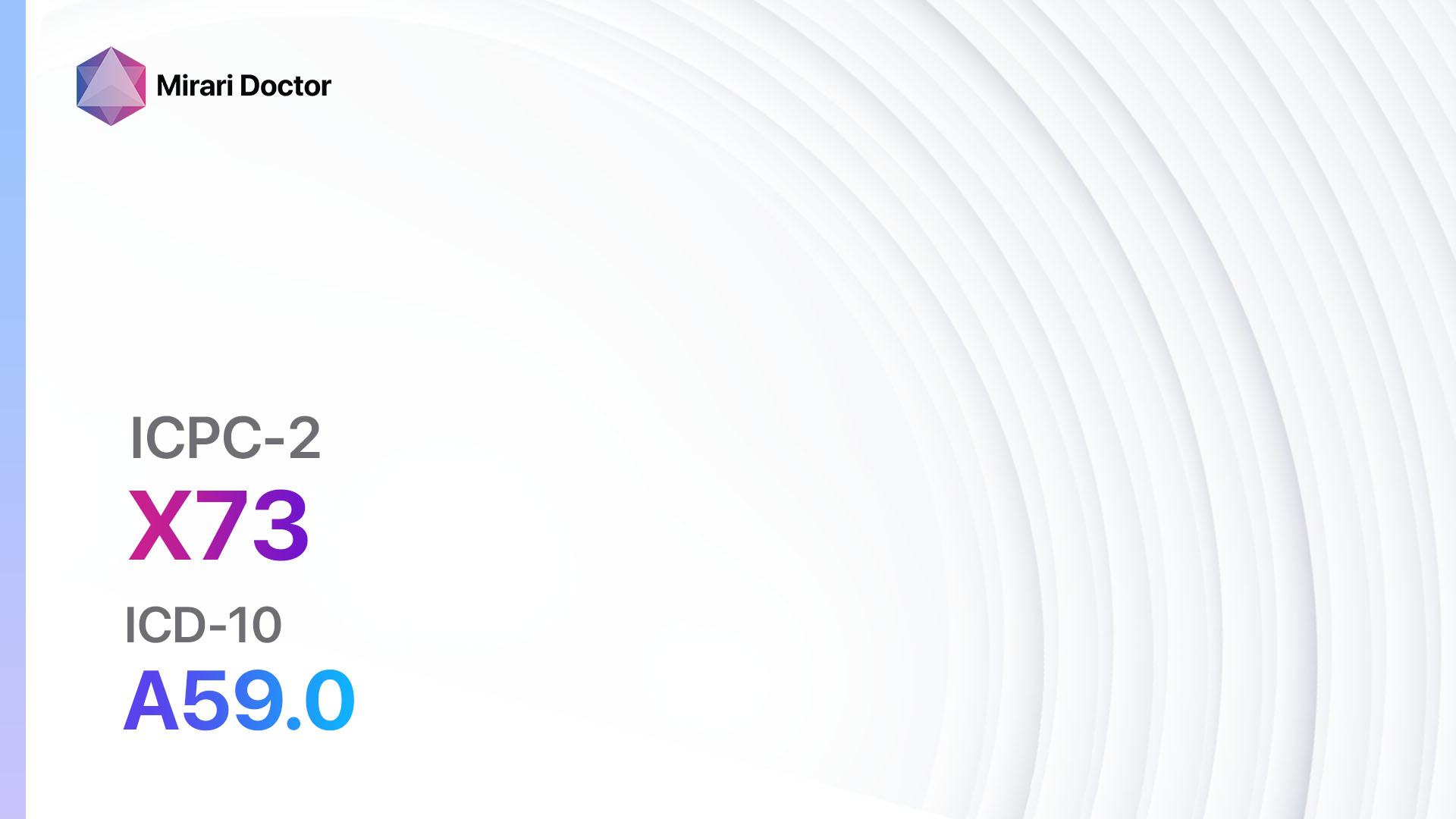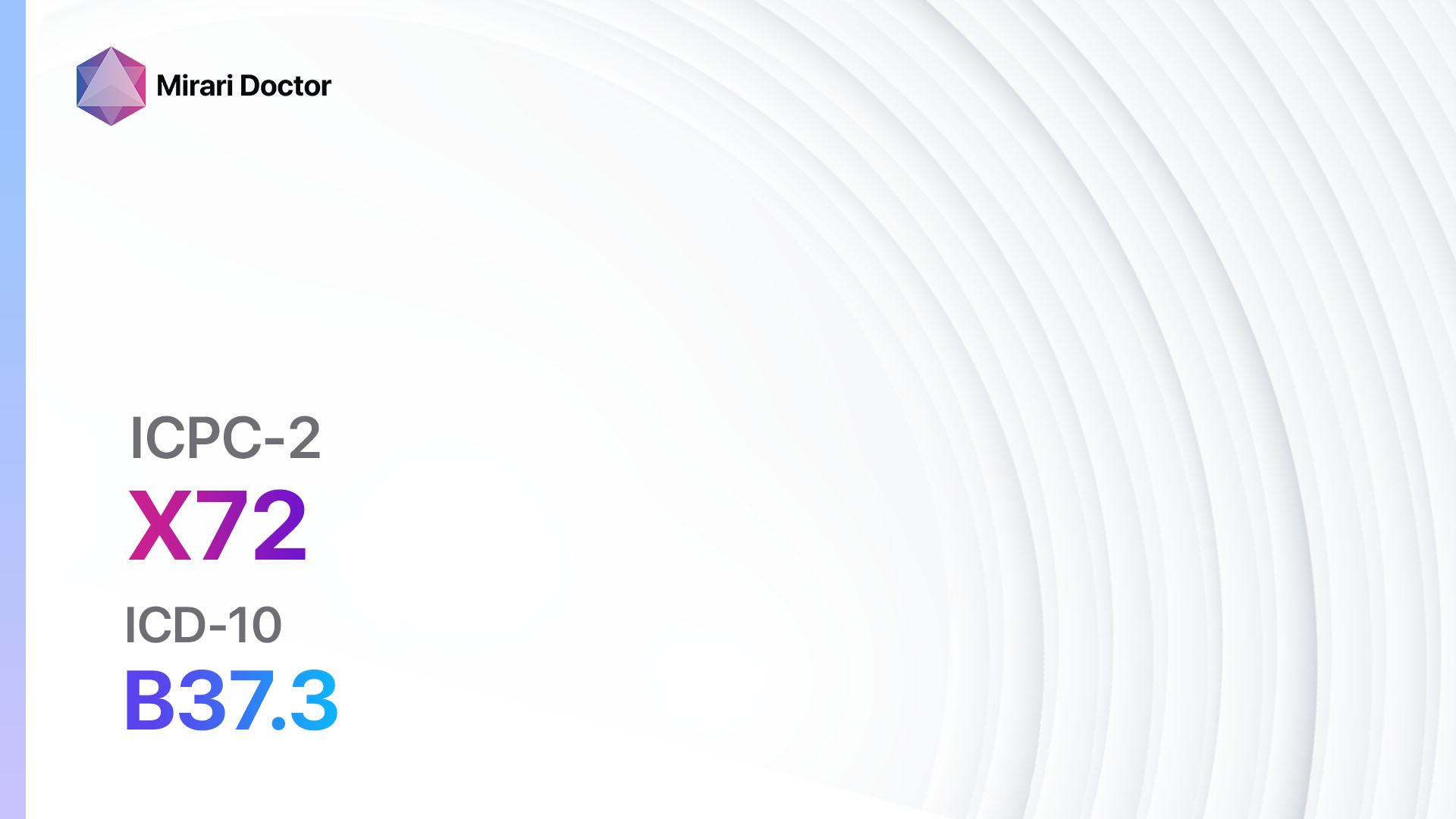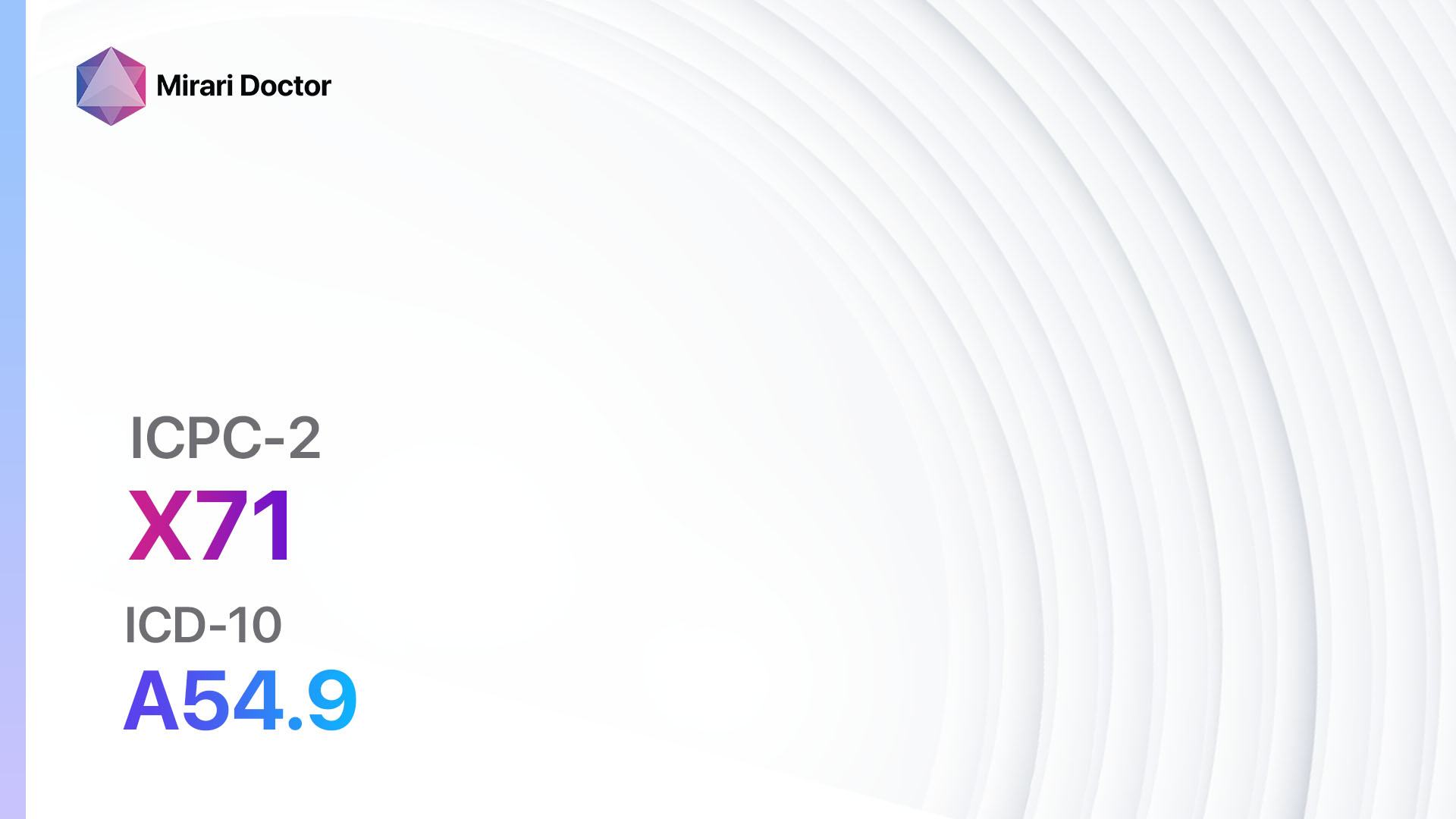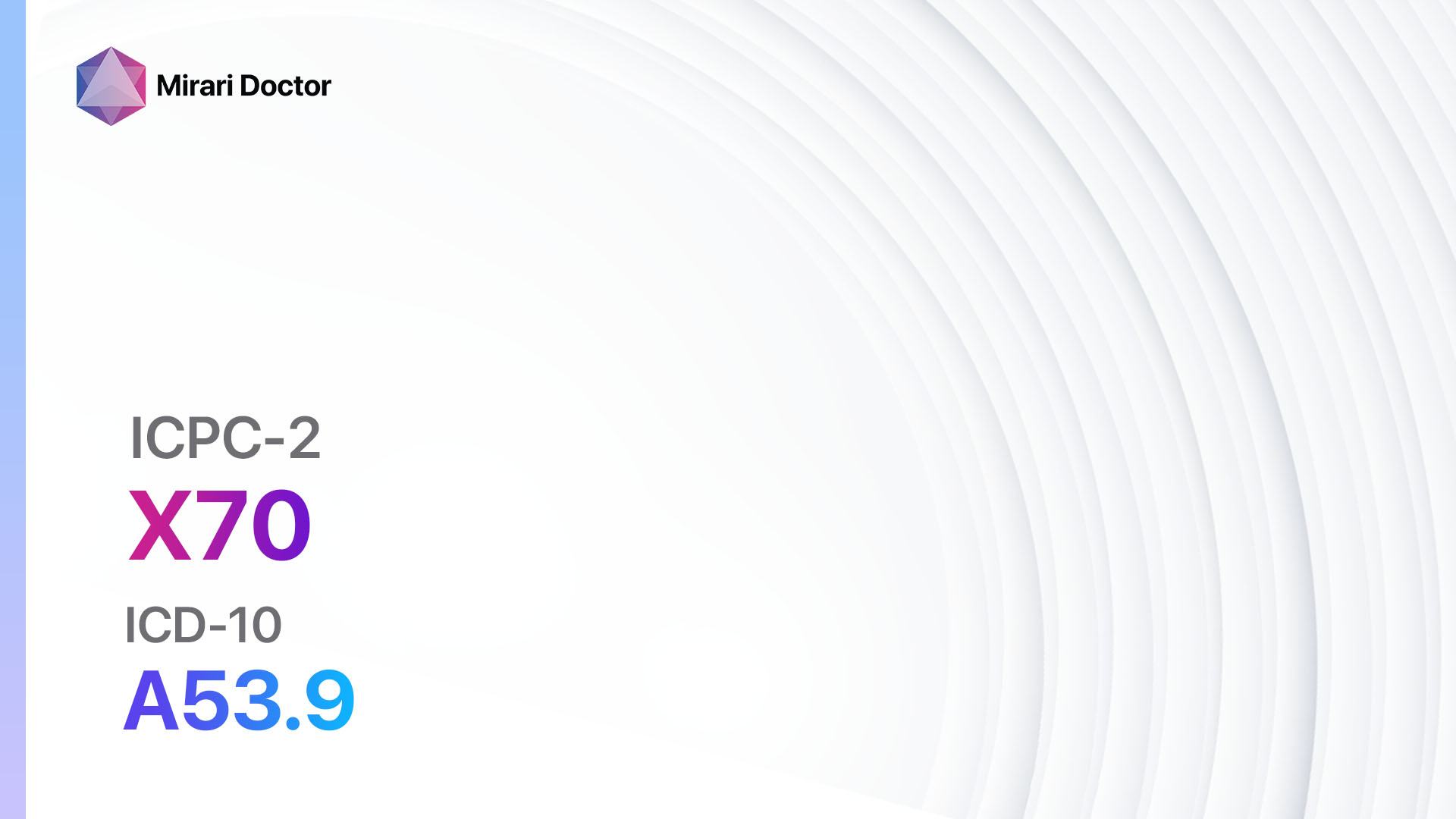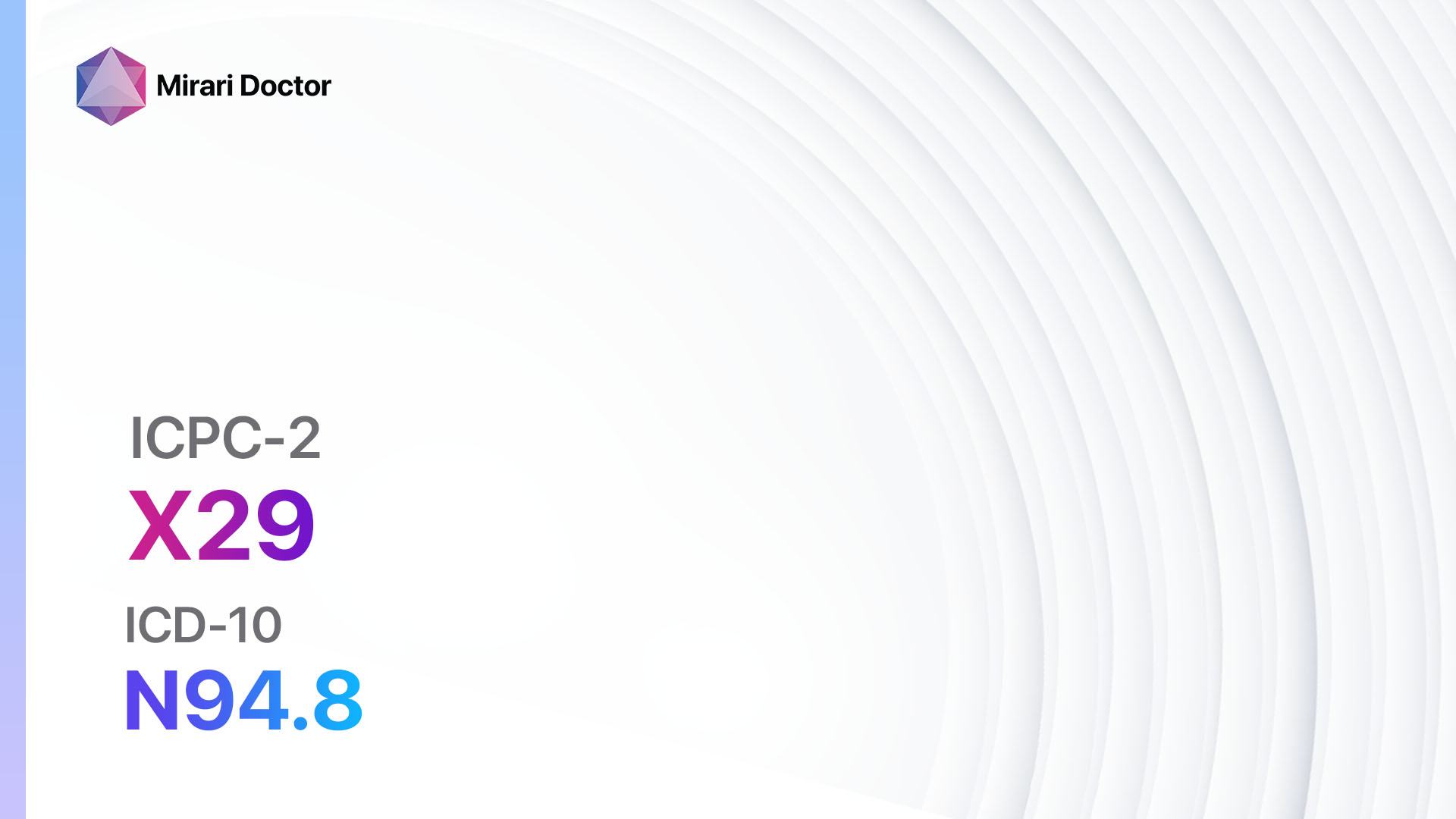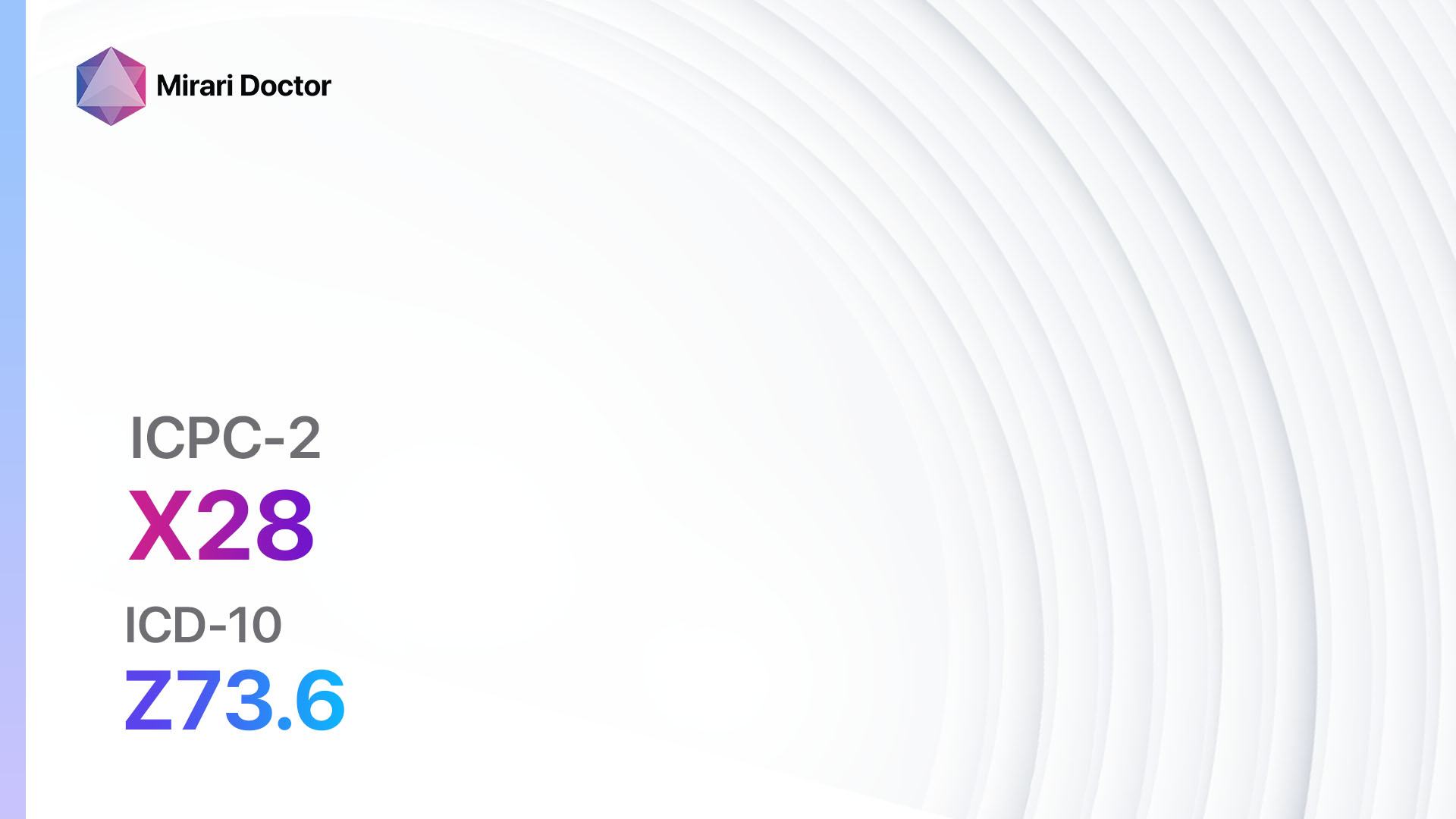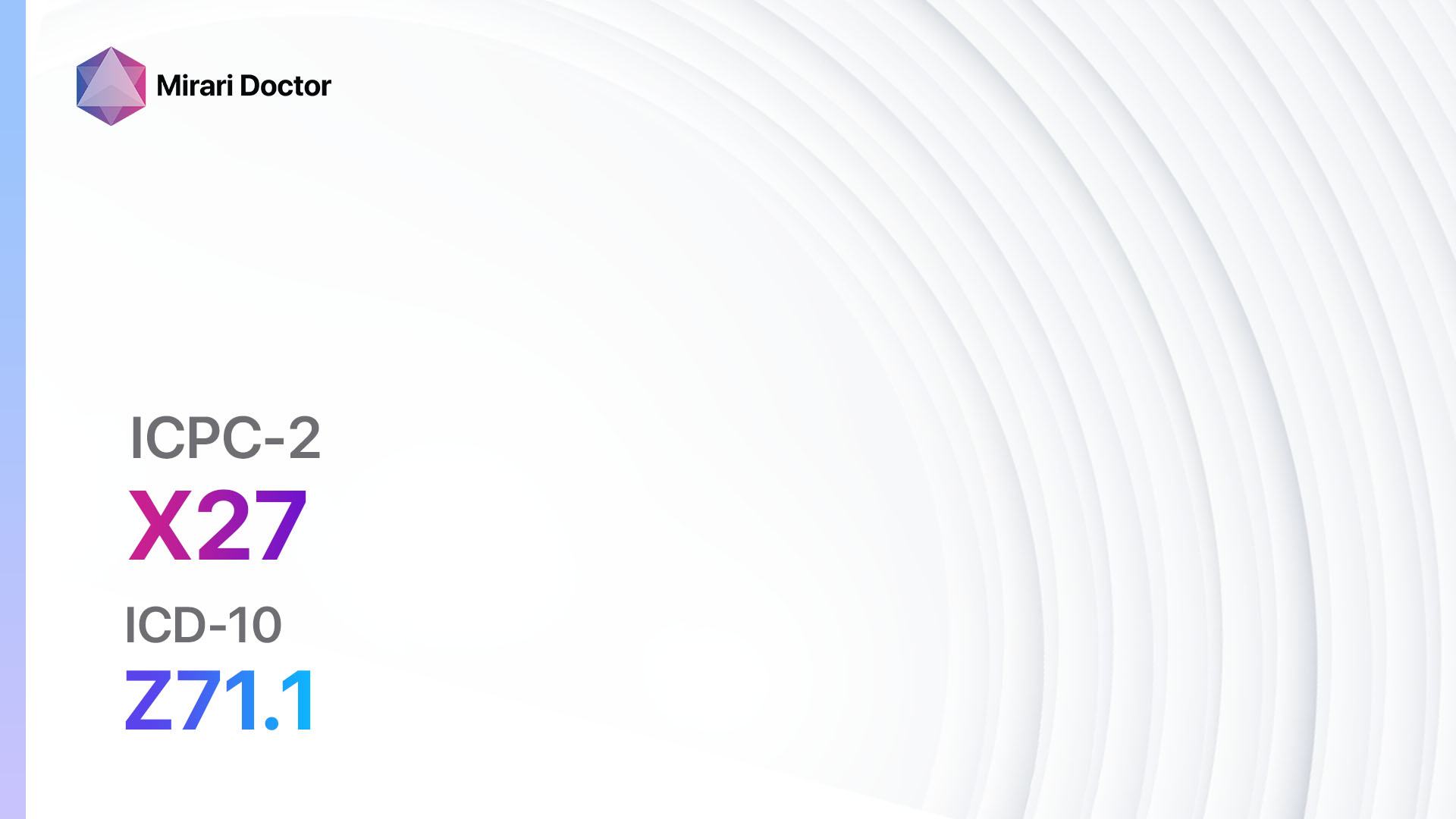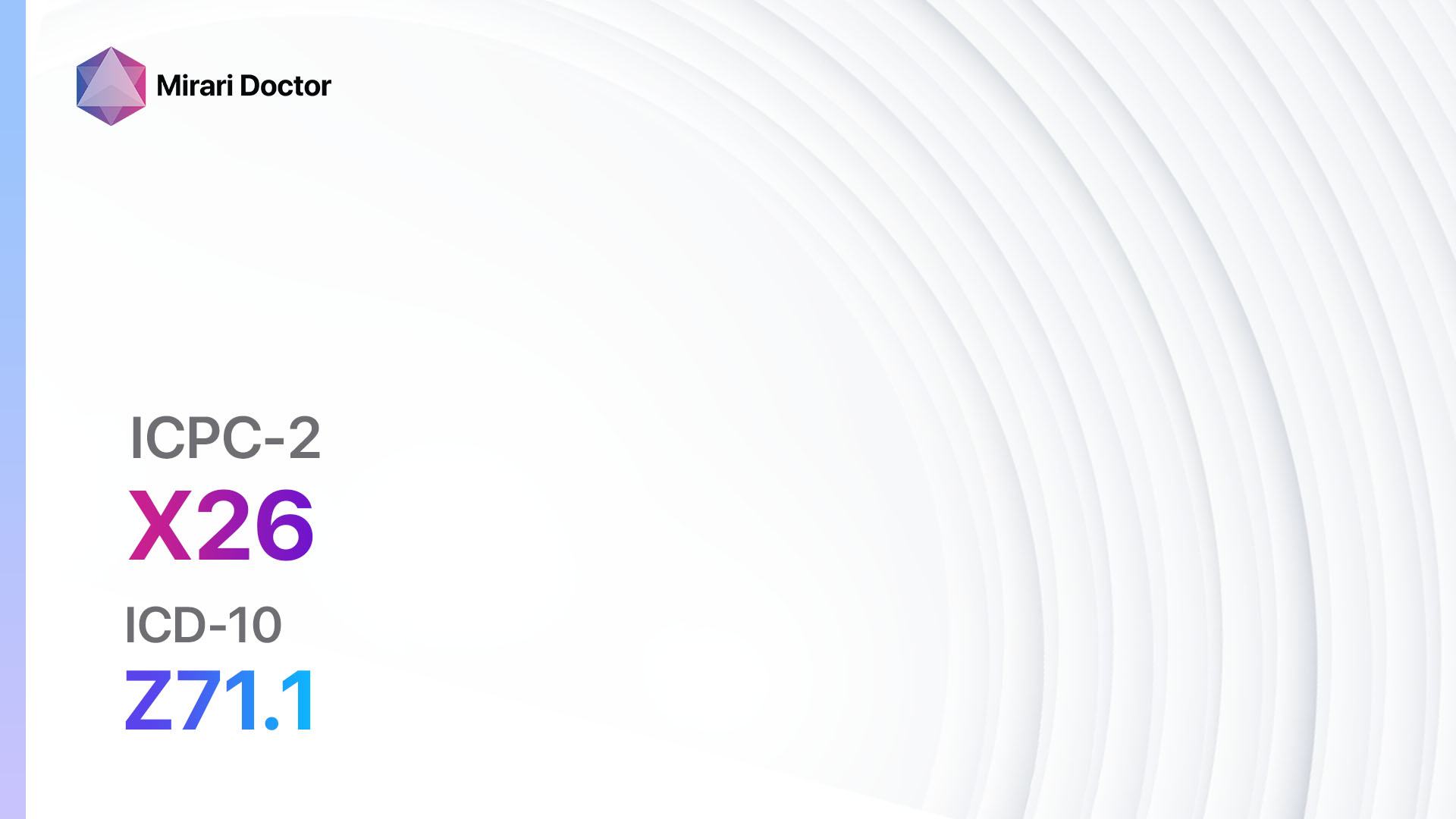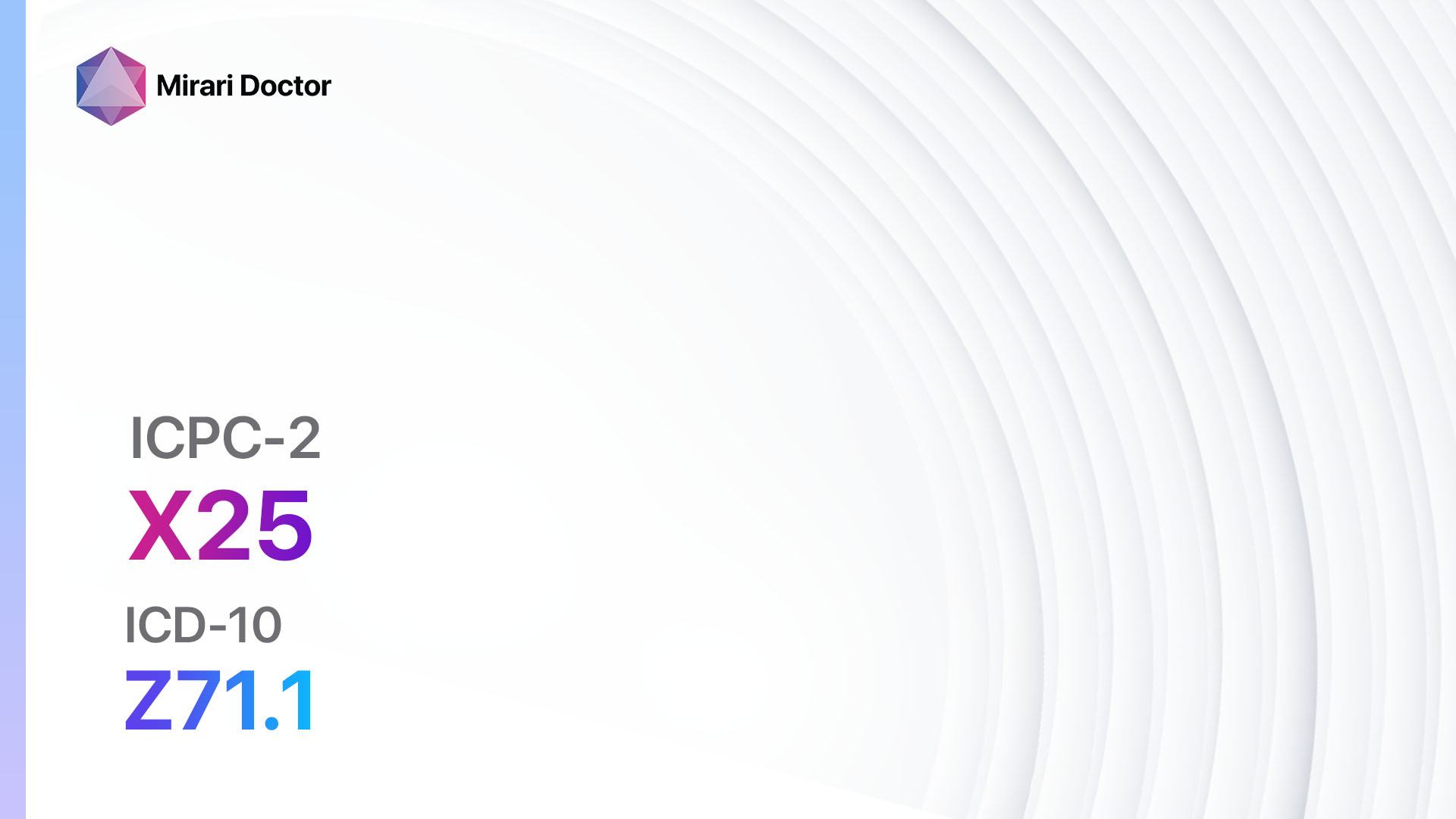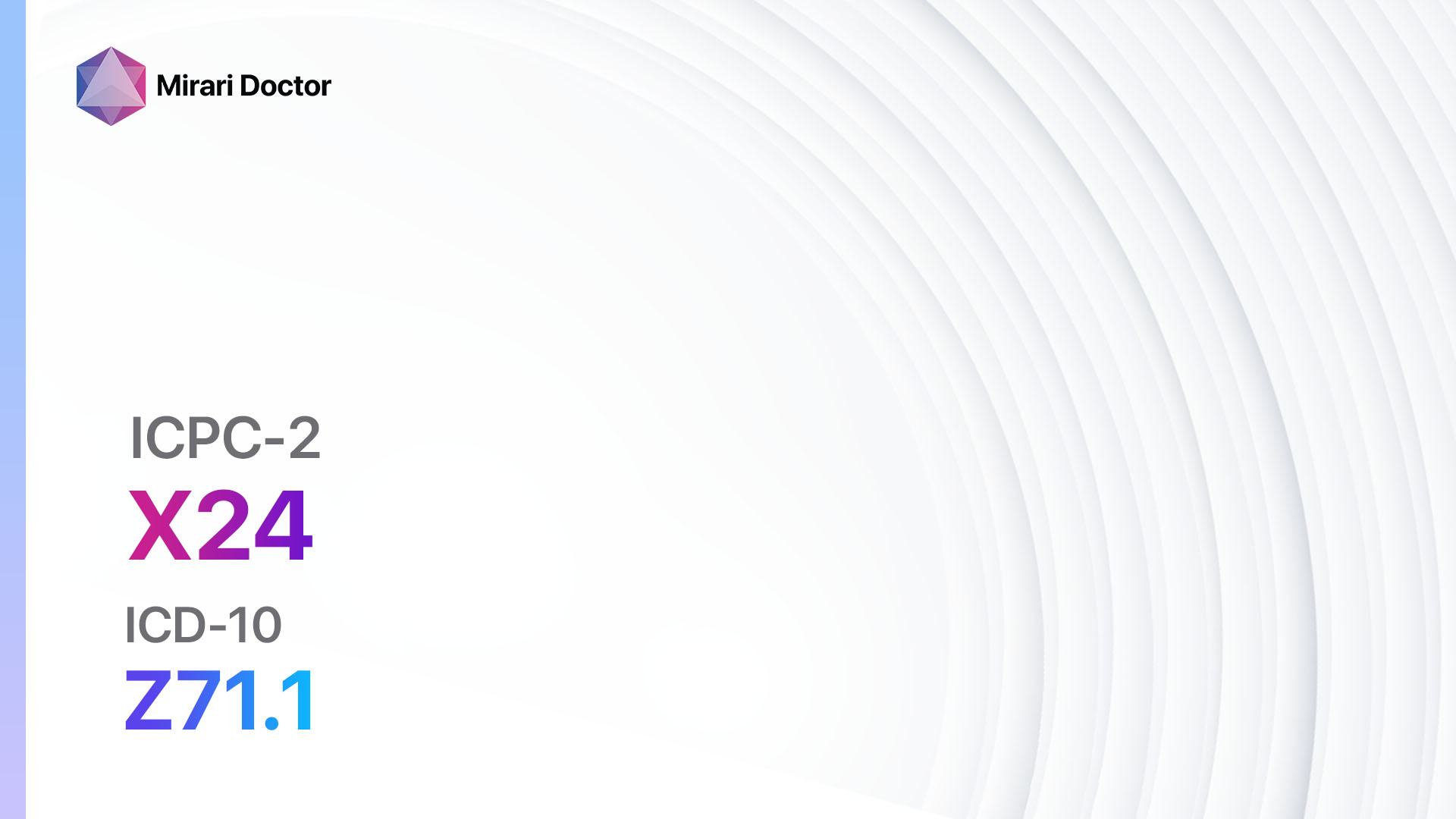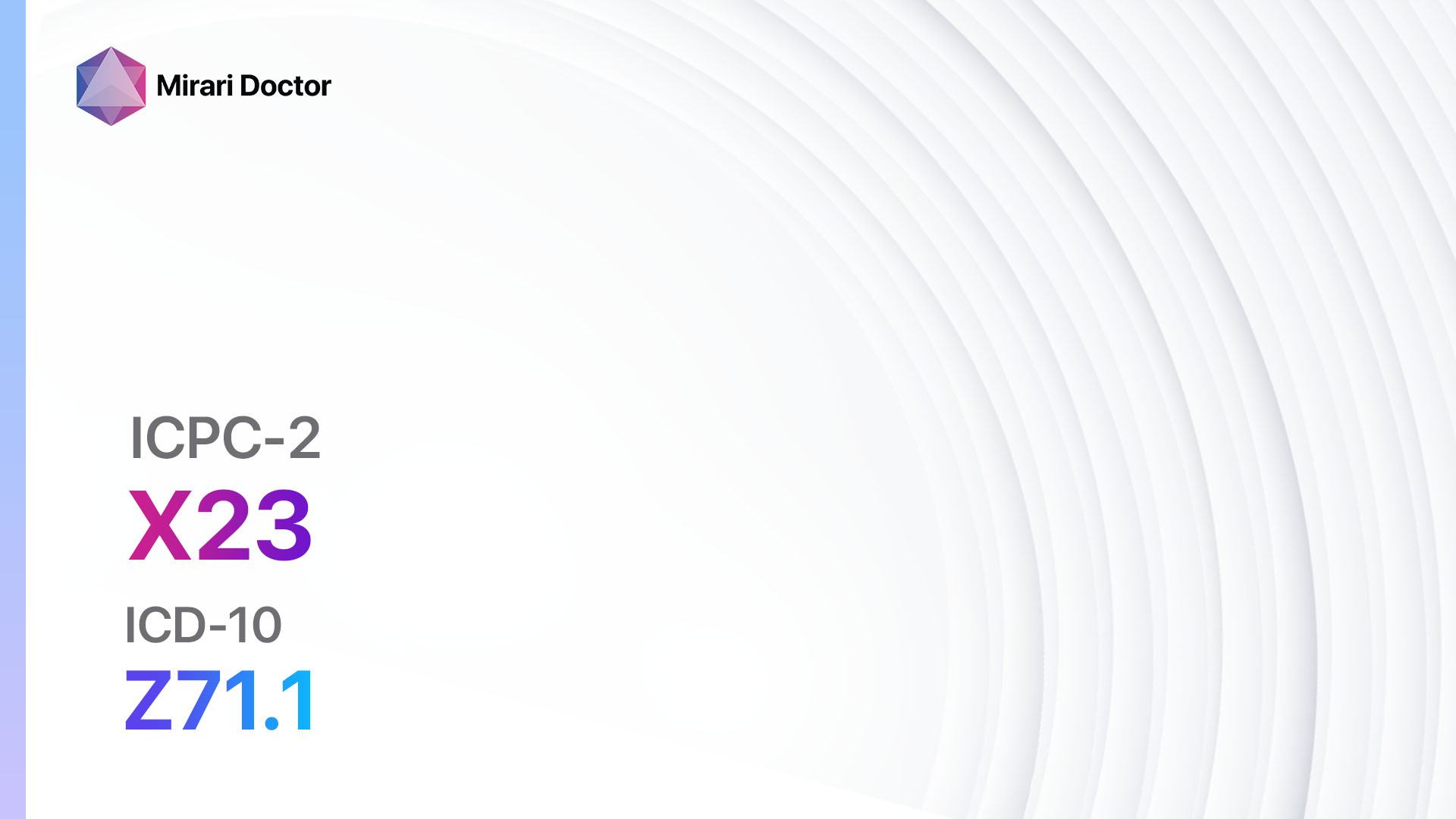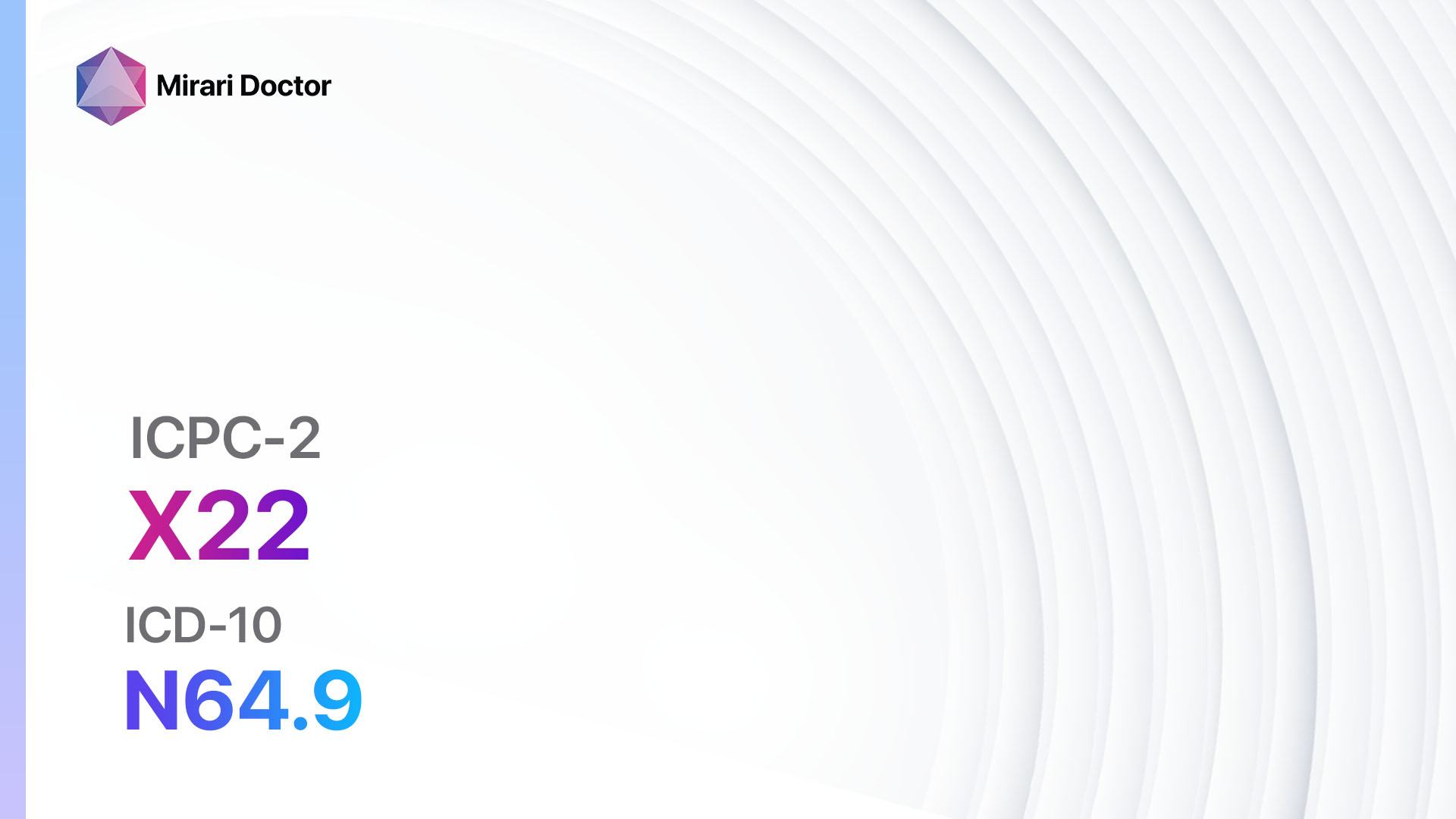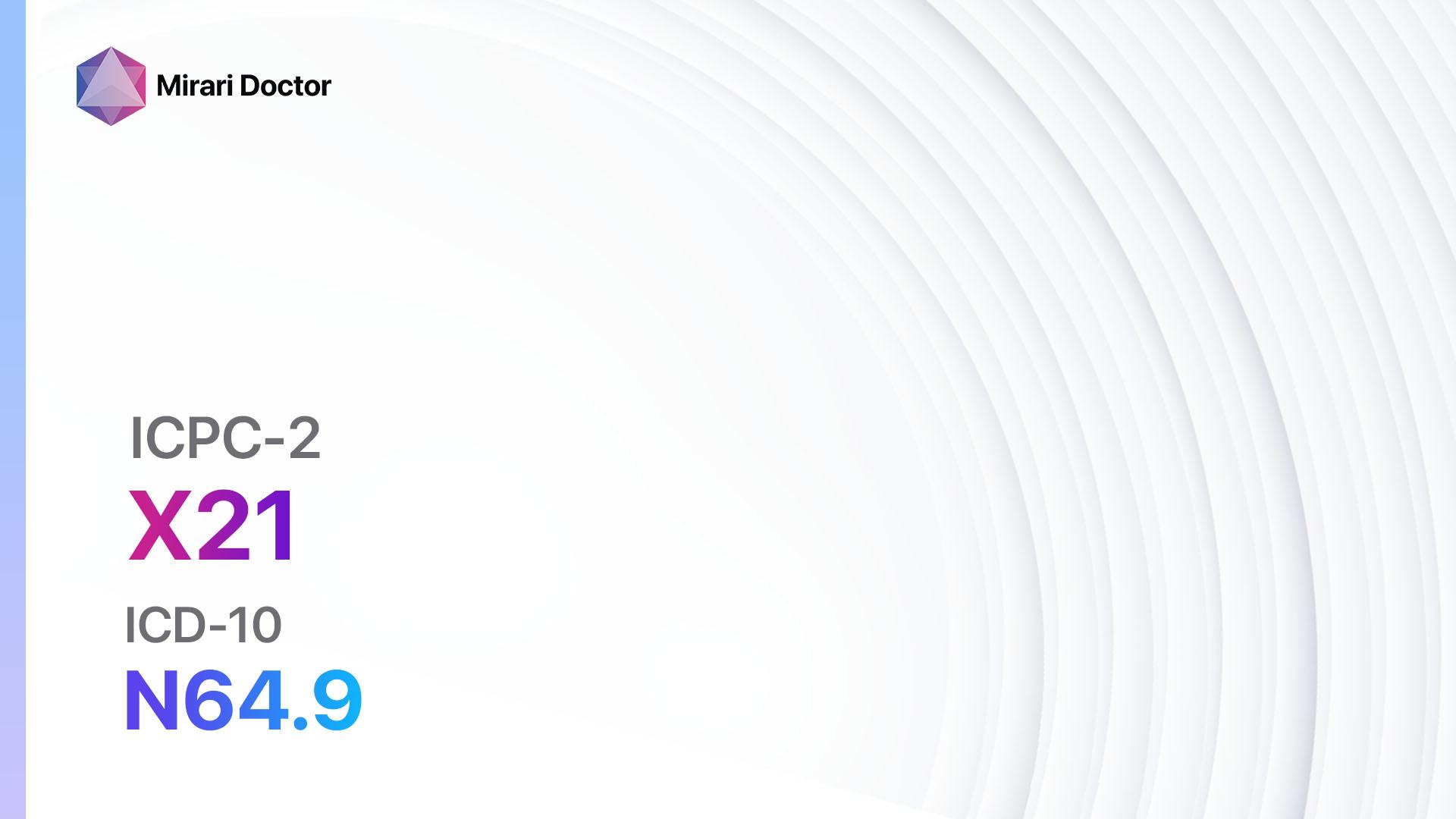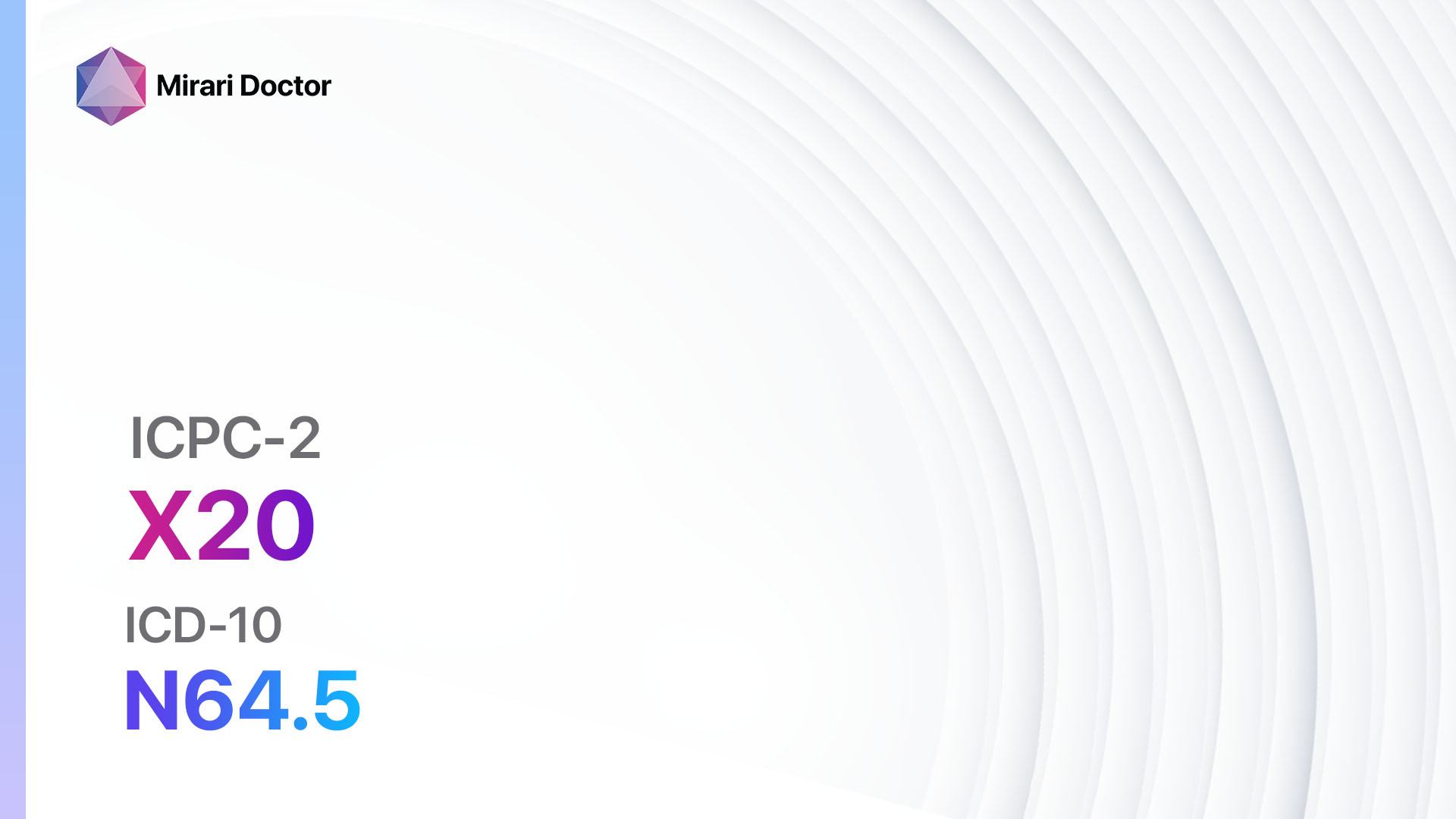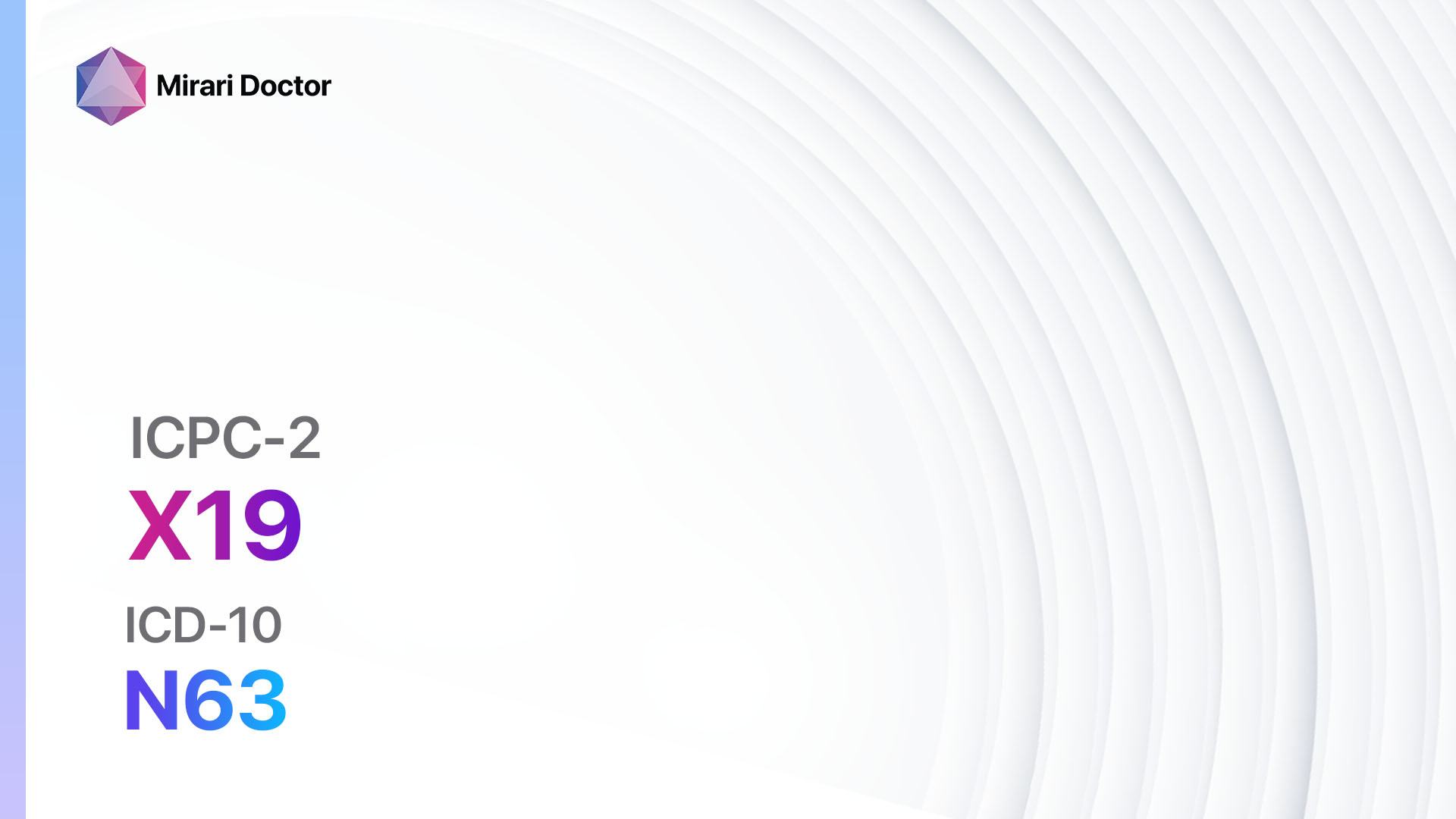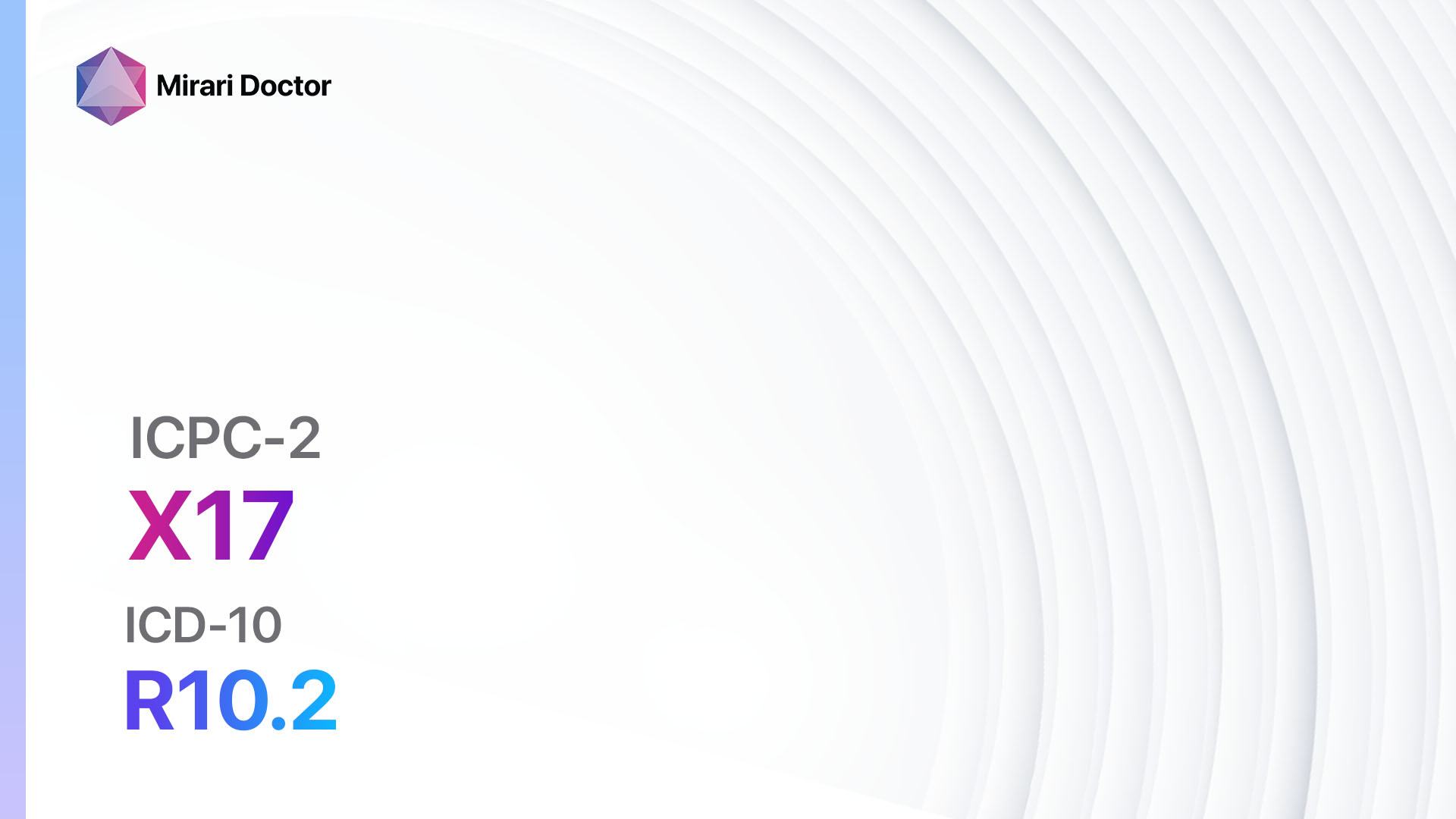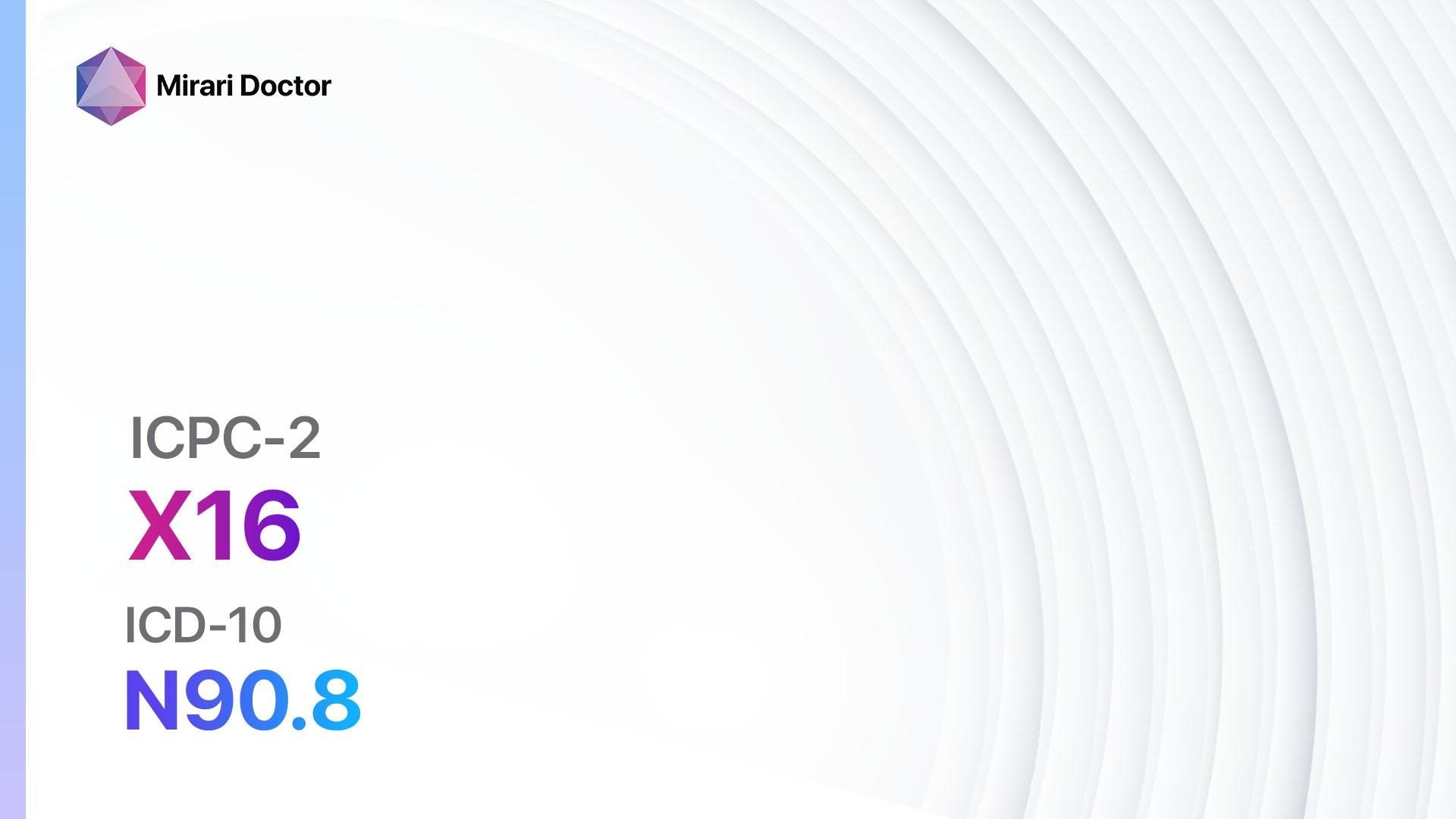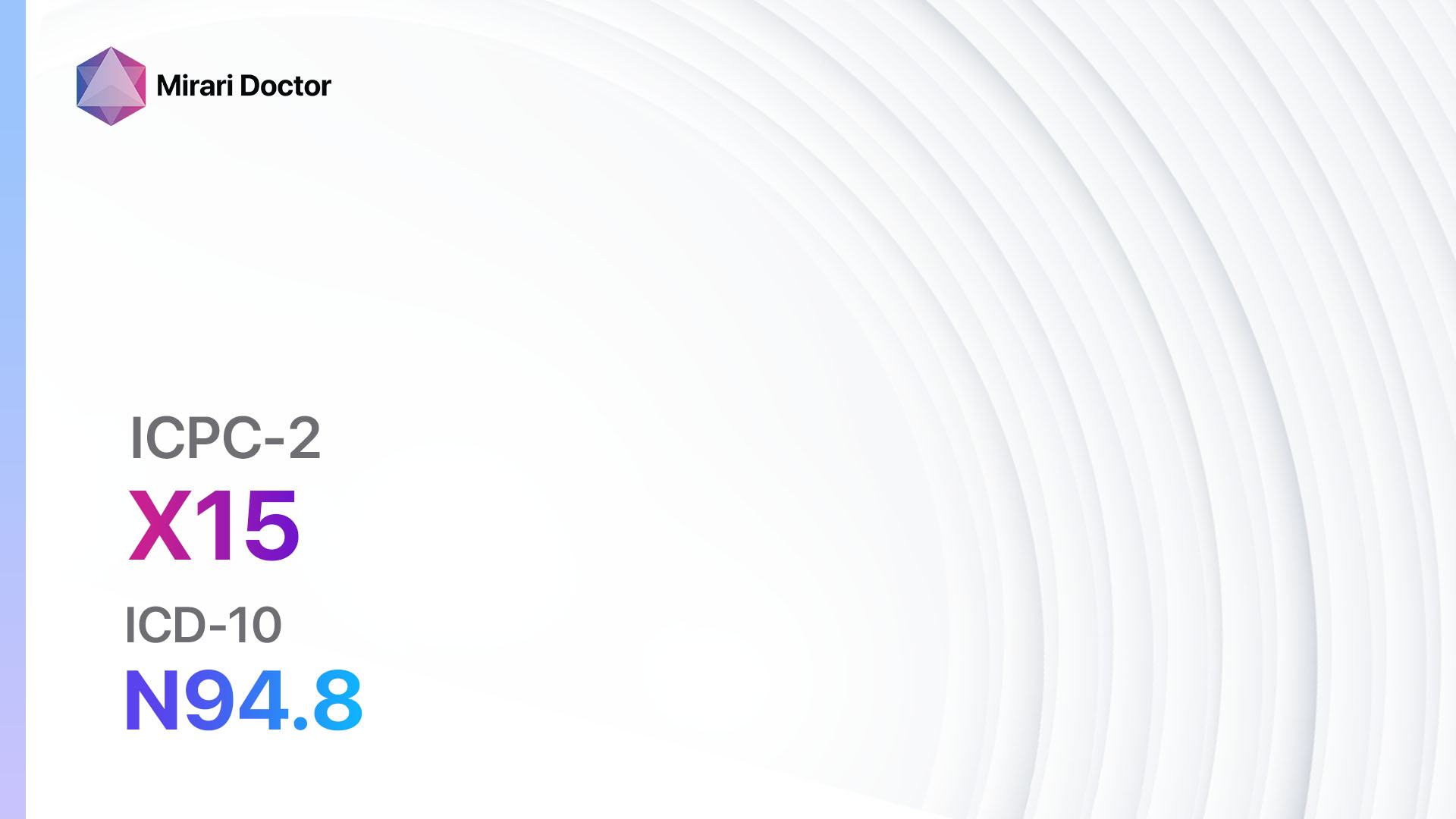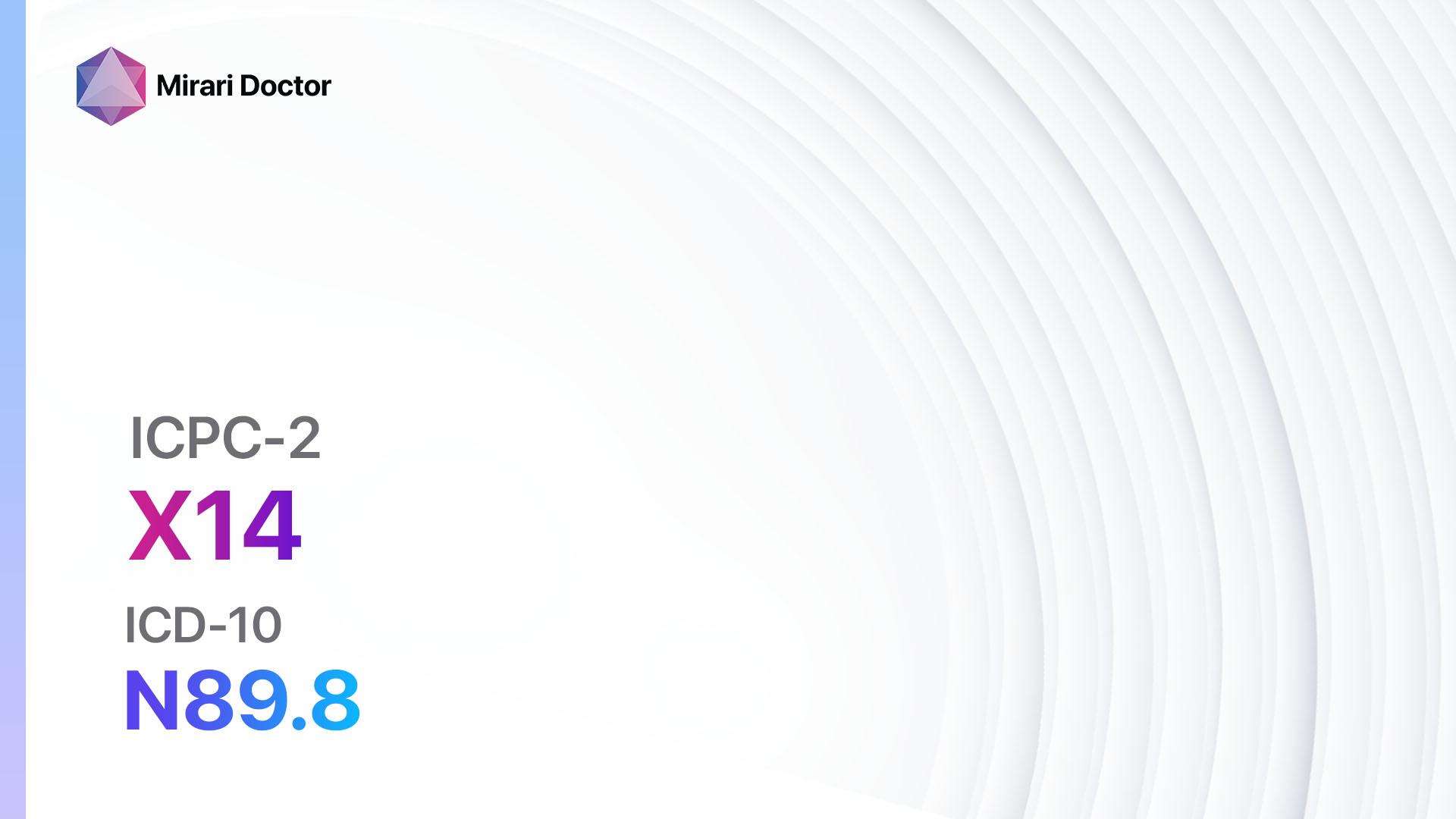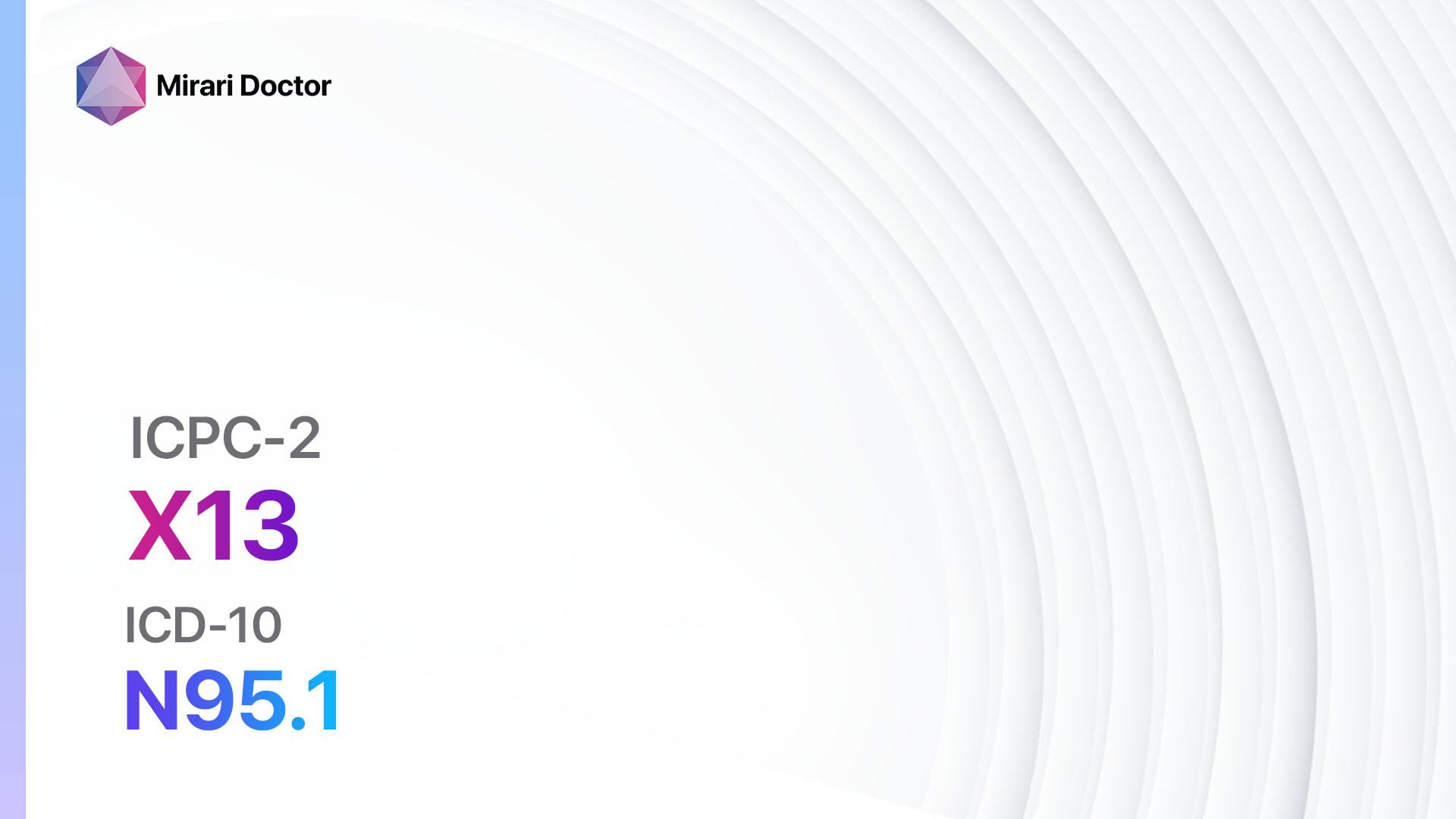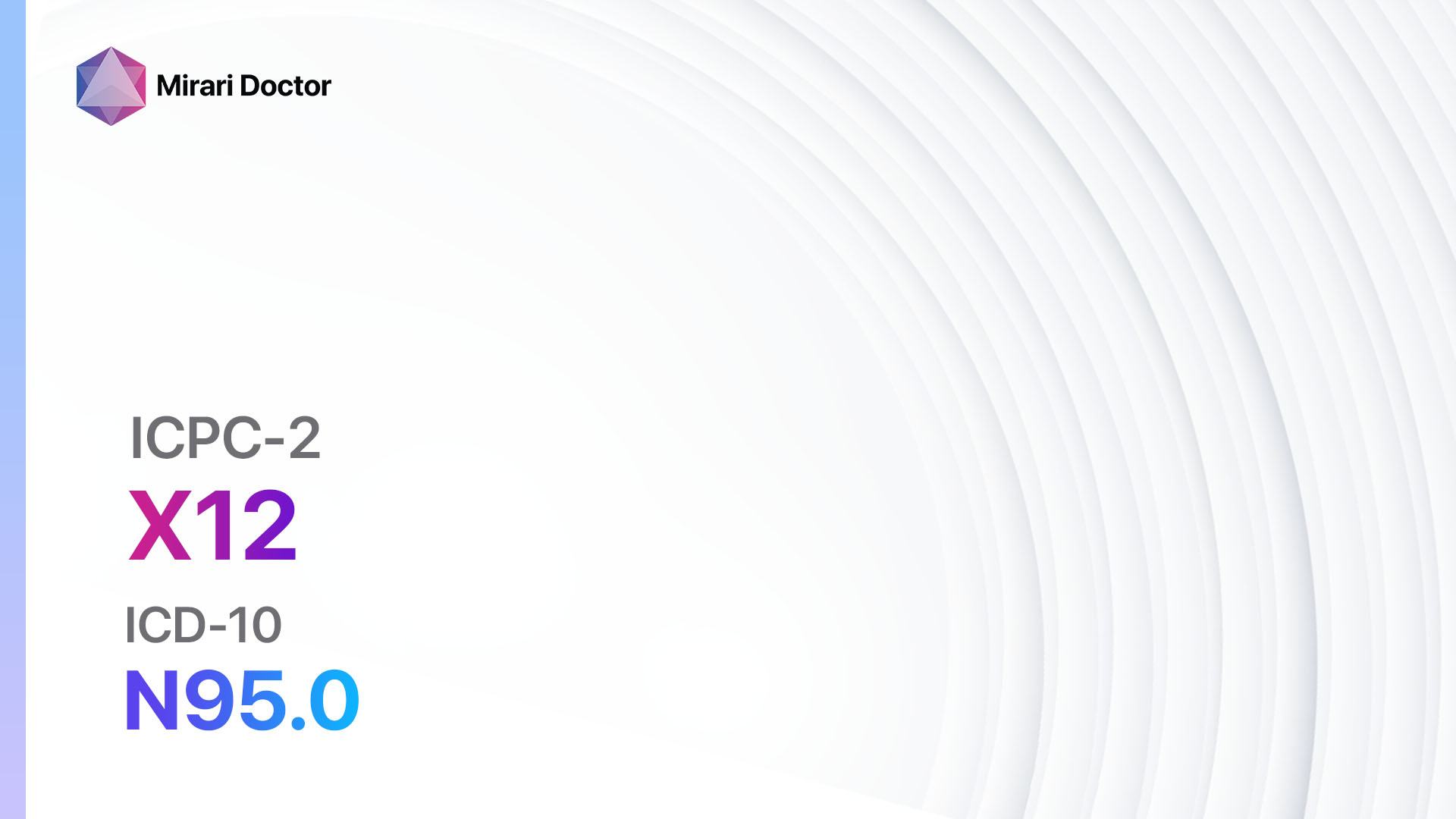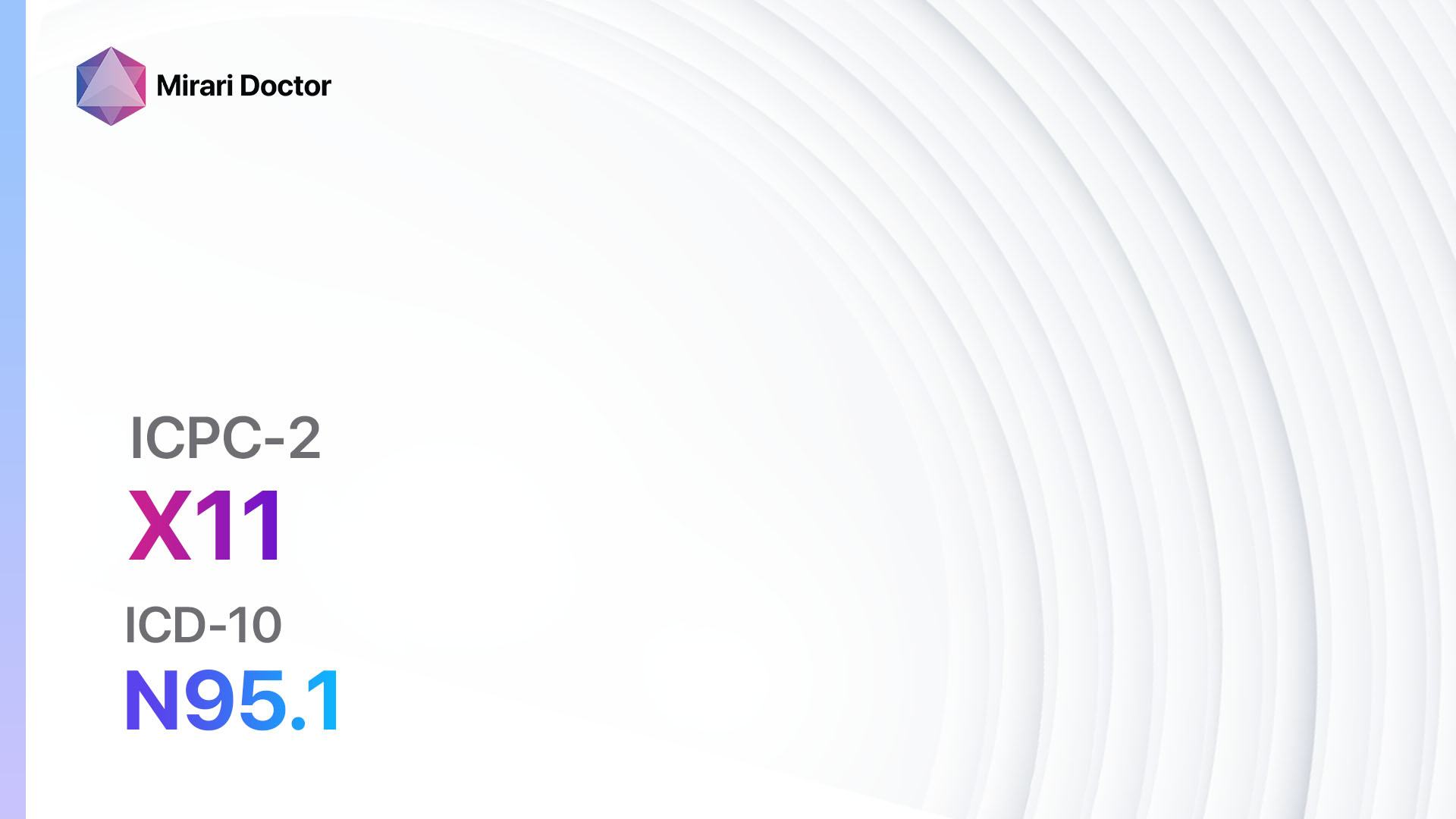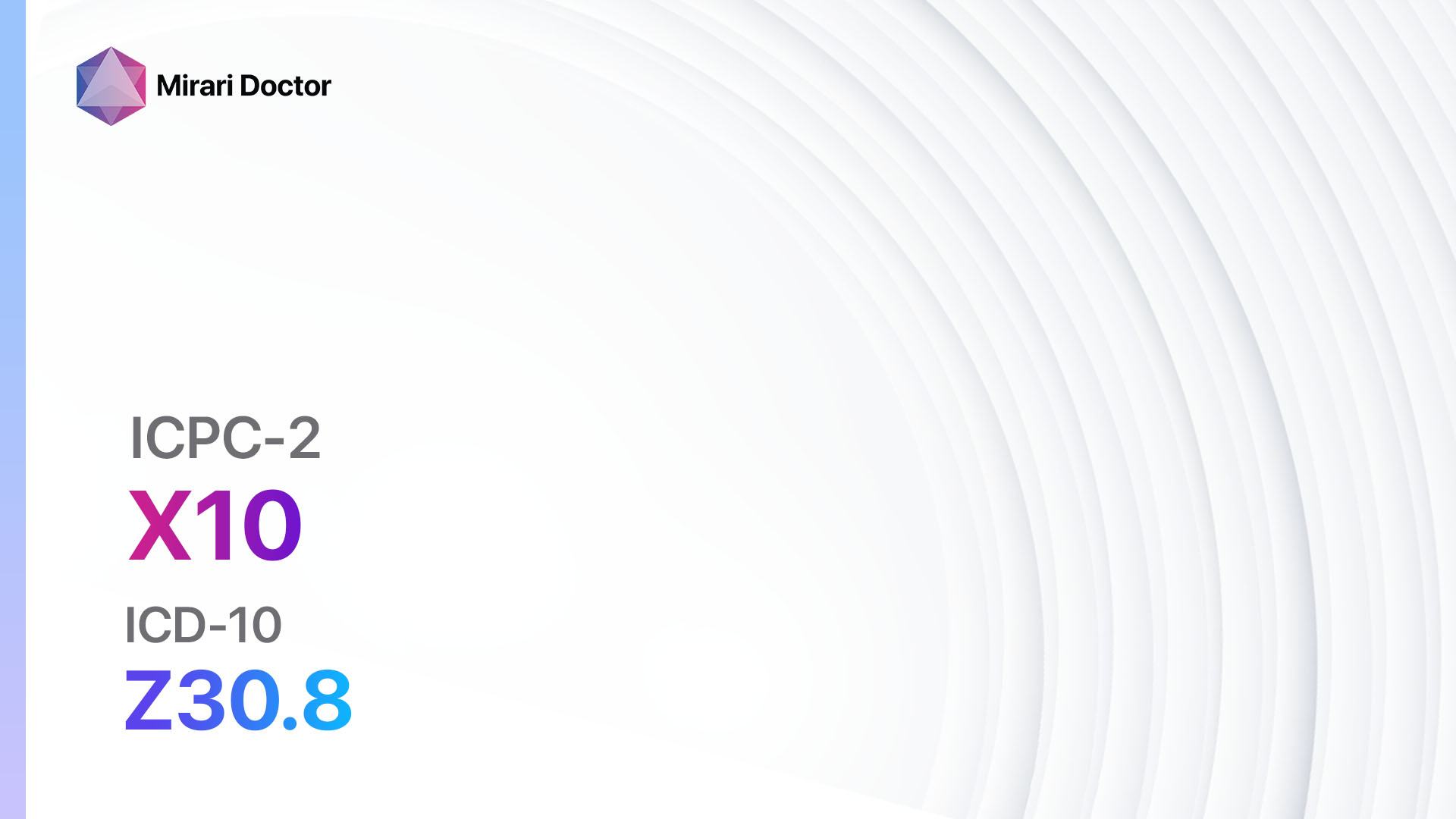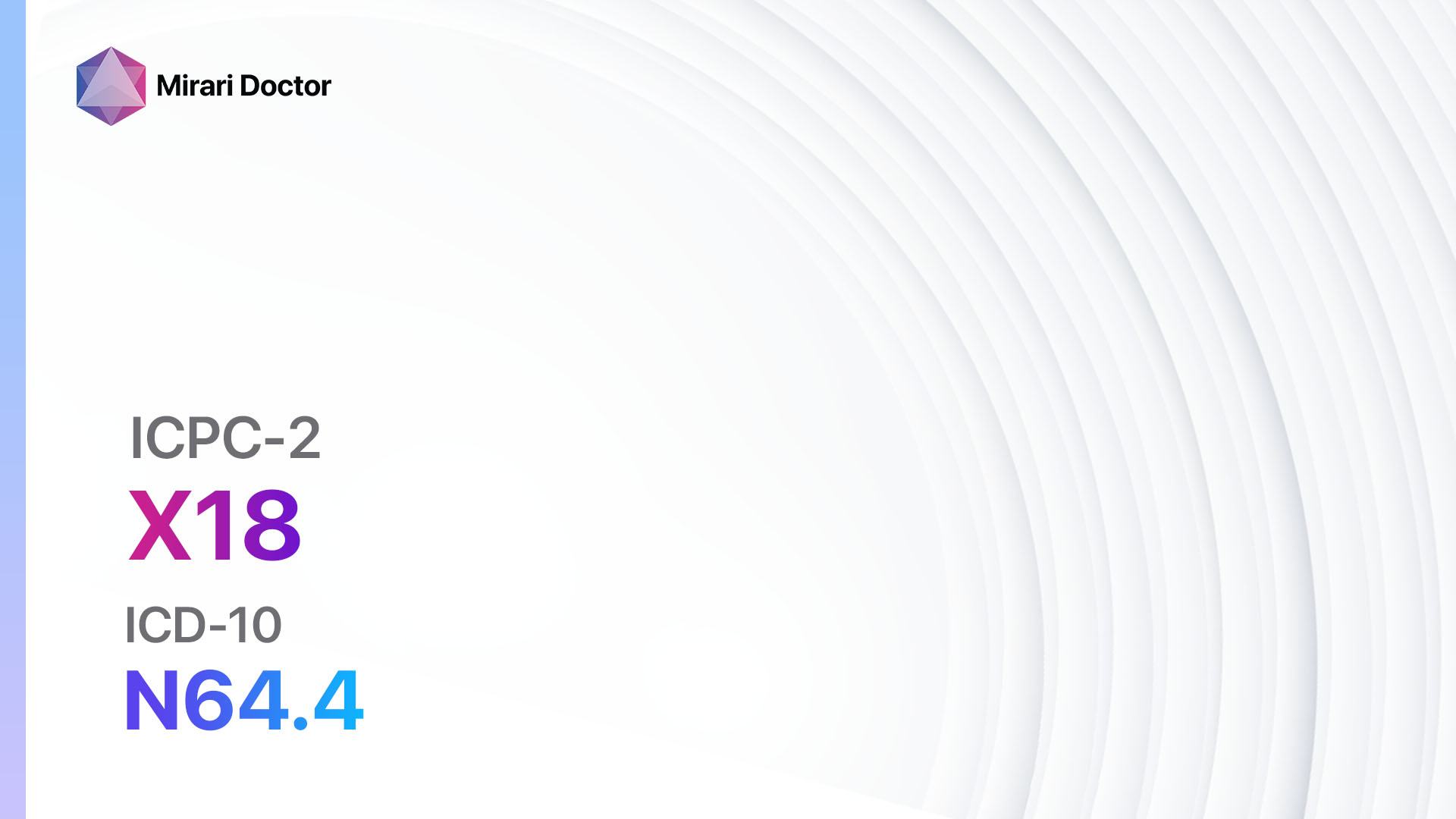
Introduction
Breast pain, also known as mastalgia, is a common symptom experienced by many women. It can range from mild discomfort to severe pain and can occur in one or both breasts[1]. Breast pain can be cyclic, occurring in relation to the menstrual cycle, or non-cyclic, not related to the menstrual cycle[2]. The aim of this guide is to provide an overview of breast pain in females, including its symptoms, causes, diagnostic steps, possible interventions, and lifestyle interventions.
Codes
Symptoms
- Breast tenderness
- Breast swelling
- Breast pain or discomfort
- Nipple pain or sensitivity
- Pain that is constant or intermittent
- Pain that is localized or diffuse[3]
Causes
- Hormonal changes during the menstrual cycle
- Fibrocystic breast changes
- Breast cysts
- Breast trauma or injury
- Infection or inflammation of the breast tissue
- Medications, such as hormonal contraceptives or hormone replacement therapy
- Breast cancer (rare)[4]
Diagnostic Steps
Medical History
- Gather information about the patient’s menstrual cycle and any changes in breast pain related to it.
- Ask about the duration, severity, and location of the breast pain.
- Inquire about any recent trauma or injury to the breast.
- Assess for any other symptoms, such as nipple discharge or breast lumps.
- Evaluate the patient’s medical history, including any previous breast conditions or surgeries[5].
Physical Examination
- Perform a thorough breast examination, including inspection and palpation of both breasts and the surrounding lymph nodes.
- Look for any signs of redness, swelling, or skin changes.
- Palpate for any breast lumps or areas of tenderness.
- Assess the patient’s nipple and areola for any abnormalities or discharge[6].
Laboratory Tests
- Blood tests: May be done to evaluate hormone levels, rule out infection, or assess for other underlying conditions.
- Breast ultrasound: Can help visualize the breast tissue and identify any cysts or other abnormalities.
- Mammogram: May be recommended for women over the age of 40 or those with concerning findings on physical examination or ultrasound.
- Breast biopsy: If a suspicious lump or abnormality is found, a biopsy may be performed to obtain a tissue sample for further evaluation[7].
Diagnostic Imaging
- Breast ultrasound: Can help visualize the breast tissue and identify any cysts or other abnormalities.
- Mammogram: May be recommended for women over the age of 40 or those with concerning findings on physical examination or ultrasound.
- Breast MRI: May be used in certain cases to provide additional information about the breast tissue[8].
Other Tests
- Fine needle aspiration: If a breast cyst is identified, a fine needle may be used to drain the fluid and relieve symptoms.
- Ductography: In cases of nipple discharge, a contrast dye may be injected into the affected duct to visualize any abnormalities.
- Thermography: This imaging technique uses infrared technology to detect changes in breast temperature, which may indicate inflammation or other abnormalities[9].
Follow-up and Patient Education
- Schedule a follow-up appointment to review the results of any diagnostic tests and discuss further management options.
- Provide education on breast self-examination and the importance of regular breast health screenings.
- Address any concerns or questions the patient may have regarding their breast pain or any potential underlying conditions[10].
Possible Interventions
Traditional Interventions
Medications:
Top 5 drugs for Breast pain female:
- Nonsteroidal anti-inflammatory drugs (NSAIDs) (e.g., Ibuprofen, Naproxen):
- Cost: Generic versions can be $3-$20/month.
- Contraindications: History of gastrointestinal bleeding, kidney disease.
- Side effects: Upset stomach, heartburn, dizziness.
- Severe side effects: Stomach ulcers, kidney damage.
- Drug interactions: Blood thinners, certain antidepressants.
- Warning: Prolonged use may increase the risk of cardiovascular events.
- Hormonal contraceptives (e.g., Combined oral contraceptives, Progestin-only pills):
- Cost: Varies depending on the specific medication and insurance coverage.
- Contraindications: History of blood clots, certain types of cancer.
- Side effects: Nausea, breast tenderness, mood changes.
- Severe side effects: Blood clots, stroke, heart attack.
- Drug interactions: Certain antibiotics, antifungal medications.
- Warning: Regular monitoring of blood pressure and other health parameters may be required.
- Danazol:
- Cost: $100-$500/month.
- Contraindications: Pregnancy, liver disease.
- Side effects: Weight gain, acne, voice changes.
- Severe side effects: Liver damage, blood clots.
- Drug interactions: Blood thinners, certain anticonvulsants.
- Warning: Regular liver function tests required.
- Selective serotonin reuptake inhibitors (SSRIs) (e.g., Fluoxetine, Sertraline):
- Cost: Generic versions can be $3-$20/month.
- Contraindications: Use of monoamine oxidase inhibitors (MAOIs), certain heart conditions.
- Side effects: Nausea, headache, sexual dysfunction.
- Severe side effects: Serotonin syndrome, increased risk of bleeding.
- Drug interactions: MAOIs, certain pain medications.
- Warning: May take several weeks to achieve full effect.
- Tamoxifen:
- Cost: $100-$500/month.
- Contraindications: History of blood clots, certain types of cancer.
- Side effects: Hot flashes, vaginal discharge, mood changes.
- Severe side effects: Blood clots, endometrial cancer.
- Drug interactions: Certain antidepressants, blood thinners.
- Warning: Regular monitoring of blood parameters and gynecological exams required.
Alternative Drugs:
- Evening primrose oil: Some studies suggest that evening primrose oil may help relieve breast pain, although evidence is limited. Cost: $10-$20/month.
- Vitamin E: This antioxidant may have a protective effect against breast pain. Cost: $5-$10/month.
- Bromocriptine: Can be used in cases of severe breast pain associated with elevated prolactin levels. Cost: $50-$100/month.
- Topical analgesics: Creams or gels containing analgesic ingredients, such as lidocaine or menthol, may provide temporary relief. Cost: $10-$20 per tube.
Surgical Procedures:
- Surgery is typically not recommended for the treatment of breast pain unless there is an underlying condition that requires intervention, such as a breast abscess or tumor.
Alternative Interventions
- Acupuncture: May help reduce breast pain and improve overall well-being. Cost: $60-$120 per session.
- Yoga and meditation: These mind-body practices may help reduce stress and alleviate breast pain. Cost: Varies depending on the location and instructor.
- Dietary modifications: Avoiding caffeine, reducing salt intake, and consuming a balanced diet rich in fruits and vegetables may help alleviate breast pain. Cost: Varies depending on individual food choices.
- Herbal supplements: Some herbs, such as chasteberry or black cohosh, may have potential benefits for reducing breast pain. Cost: Varies depending on the specific supplement.
Lifestyle Interventions
- Wearing a supportive bra: A well-fitting bra can provide support and reduce breast discomfort. Cost: Varies depending on the brand and style.
- Applying heat or cold packs: Heat or cold therapy applied to the breasts may help alleviate pain and reduce inflammation. Cost: Varies depending on the type of pack used.
- Stress reduction techniques: Engaging in activities that promote relaxation, such as deep breathing exercises or taking a warm bath, may help reduce breast pain. Cost: Varies depending on individual preferences.
- Regular exercise: Engaging in regular physical activity can help improve overall breast health and reduce breast pain. Cost: Varies depending on individual preferences and access to exercise facilities.
It is important to note that the cost ranges provided are approximate and may vary depending on the location and availability of the interventions. It is recommended to consult with a healthcare professional for personalized recommendations and to discuss any potential risks or contraindications associated with the interventions.
Mirari Cold Plasma Alternative Intervention
Understanding Mirari Cold Plasma
- Safe and Non-Invasive Treatment: Mirari Cold Plasma is a safe and non-invasive treatment option for various skin conditions. It does not require incisions, minimizing the risk of scarring, bleeding, or tissue damage.
- Efficient Extraction of Foreign Bodies: Mirari Cold Plasma facilitates the removal of foreign bodies from the skin by degrading and dissociating organic matter, allowing easier access and extraction.
- Pain Reduction and Comfort: Mirari Cold Plasma has a local analgesic effect, providing pain relief during the treatment, making it more comfortable for the patient.
- Reduced Risk of Infection: Mirari Cold Plasma has antimicrobial properties, effectively killing bacteria and reducing the risk of infection.
- Accelerated Healing and Minimal Scarring: Mirari Cold Plasma stimulates wound healing and tissue regeneration, reducing healing time and minimizing the formation of scars.
Mirari Cold Plasma Prescription
Video instructions for using Mirari Cold Plasma Device – X18 Breast pain female (ICD-10:N64.4)
| Mild | Moderate | Severe |
| Mode setting: 1 (Infection) Location: 0 (Localized) Morning: 15 minutes, Evening: 15 minutes |
Mode setting: 1 (Infection) Location: 0 (Localized) Morning: 30 minutes, Lunch: 30 minutes, Evening: 30 minutes |
Mode setting: 1 (Infection) Location: 0 (Localized) Morning: 30 minutes, Lunch: 30 minutes, Evening: 30 minutes |
| Mode setting: 2 (Wound Healing) Location: 0 (Localized) Morning: 15 minutes, Evening: 15 minutes |
Mode setting: 2 (Wound Healing) Location: 0 (Localized) Morning: 30 minutes, Lunch: 30 minutes, Evening: 30 minutes |
Mode setting: 2 (Wound Healing) Location: 0 (Localized) Morning: 30 minutes, Lunch: 30 minutes, Evening: 30 minutes |
| Mode setting: 3 (Antiviral Therapy) Location: 0 (Localized) Morning: 15 minutes, Evening: 15 minutes |
Mode setting: 3 (Antiviral Therapy) Location: 0 (Localized) Morning: 30 minutes, Lunch: 30 minutes, Evening: 30 minutes |
Mode setting: 3 (Antiviral Therapy) Location: 0 (Localized) Morning: 30 minutes, Lunch: 30 minutes, Evening: 30 minutes |
| Mode setting: 7 (Immunotherapy) Location: 1 (Sacrum) Morning: 15 minutes, Evening: 15 minutes |
Mode setting: 7 (Immunotherapy) Location: 1 (Sacrum) Morning: 30 minutes, Lunch: 30 minutes, Evening: 30 minutes |
Mode setting: 7 (Immunotherapy) Location: 1 (Sacrum) Morning: 30 minutes, Lunch: 30 minutes, Evening: 30 minutes |
| Total Morning: 60 minutes approx. $10 USD, Evening: 60 minutes approx. $10 USD |
Total Morning: 120 minutes approx. $20 USD, Lunch: 120 minutes approx. $20 USD, Evening: 120 minutes approx. $20 USD, |
Total Morning: 120 minutes approx. $20 USD, Lunch: 120 minutes approx. $20 USD, Evening: 120 minutes approx. $20 USD, |
| Usual treatment for 7-60 days approx. $140 USD – $1200 USD | Usual treatment for 6-8 weeks approx. $2,520 USD – $3,360 USD |
Usual treatment for 3-6 months approx. $5,400 USD – $10,800 USD
|
 |
|
Use the Mirari Cold Plasma device to treat Breast pain female effectively.
WARNING: MIRARI COLD PLASMA IS DESIGNED FOR THE HUMAN BODY WITHOUT ANY ARTIFICIAL OR THIRD PARTY PRODUCTS. USE OF OTHER PRODUCTS IN COMBINATION WITH MIRARI COLD PLASMA MAY CAUSE UNPREDICTABLE EFFECTS, HARM OR INJURY. PLEASE CONSULT A MEDICAL PROFESSIONAL BEFORE COMBINING ANY OTHER PRODUCTS WITH USE OF MIRARI.
Step 1: Cleanse the Skin
- Start by cleaning the affected area of the skin with a gentle cleanser or mild soap and water. Gently pat the area dry with a clean towel.
Step 2: Prepare the Mirari Cold Plasma device
- Ensure that the Mirari Cold Plasma device is fully charged or has fresh batteries as per the manufacturer’s instructions. Make sure the device is clean and in good working condition.
- Switch on the Mirari device using the power button or by following the specific instructions provided with the device.
- Some Mirari devices may have adjustable settings for intensity or treatment duration. Follow the manufacturer’s instructions to select the appropriate settings based on your needs and the recommended guidelines.
Step 3: Apply the Device
- Place the Mirari device in direct contact with the affected area of the skin. Gently glide or hold the device over the skin surface, ensuring even coverage of the area experiencing.
- Slowly move the Mirari device in a circular motion or follow a specific pattern as indicated in the user manual. This helps ensure thorough treatment coverage.
Step 4: Monitor and Assess:
- Keep track of your progress and evaluate the effectiveness of the Mirari device in managing your Breast pain female. If you have any concerns or notice any adverse reactions, consult with your health care professional.
Note
This guide is for informational purposes only and should not replace the advice of a medical professional. Always consult with your healthcare provider or a qualified medical professional for personal advice, diagnosis, or treatment. Do not solely rely on the information presented here for decisions about your health. Use of this information is at your own risk. The authors of this guide, nor any associated entities or platforms, are not responsible for any potential adverse effects or outcomes based on the content.
Mirari Cold Plasma System Disclaimer
- Purpose: The Mirari Cold Plasma System is a Class 2 medical device designed for use by trained healthcare professionals. It is registered for use in Thailand and Vietnam. It is not intended for use outside of these locations.
- Informational Use: The content and information provided with the device are for educational and informational purposes only. They are not a substitute for professional medical advice or care.
- Variable Outcomes: While the device is approved for specific uses, individual outcomes can differ. We do not assert or guarantee specific medical outcomes.
- Consultation: Prior to utilizing the device or making decisions based on its content, it is essential to consult with a Certified Mirari Tele-Therapist and your medical healthcare provider regarding specific protocols.
- Liability: By using this device, users are acknowledging and accepting all potential risks. Neither the manufacturer nor the distributor will be held accountable for any adverse reactions, injuries, or damages stemming from its use.
- Geographical Availability: This device has received approval for designated purposes by the Thai and Vietnam FDA. As of now, outside of Thailand and Vietnam, the Mirari Cold Plasma System is not available for purchase or use.
References
- Cleveland Clinic. (2021). Breast Pain (Mastalgia): Causes, Treatment & Prevention. Retrieved from https://my.clevelandclinic.org/health/diseases/15469-breast-pain-mastalgia
- Mayo Clinic. (2021). Breast pain – Diagnosis and treatment. Retrieved from https://www.mayoclinic.org/diseases-conditions/breast-pain/diagnosis-treatment/drc-20350426
- Healthline. (2022). When to Worry About Breast Pain: Causes, Diagnosis, Treatment. Retrieved from https://www.healthline.com/health/womens-health/when-to-worry-about-breast-pain
- Li, J., & Shao, Z. (2020). Work-up and management of breast pain. Annals of Breast Surgery, 4, 17. Retrieved from https://abs.amegroups.com/article/view/6968/html
- MSD Manual Professional Edition. (2024). Mastalgia (Breast Pain). Retrieved from https://www.msdmanuals.com/en-kr/professional/gynecology-and-obstetrics/breast-disorders/mastalgia-breast-pain
- Groen, J. W., Grosfeld, S., Wilschut, J. A., Bramer, W. M., Ernst, M. F., & Mullender, M. M. (2017). Cyclic and non-cyclic breast-pain: A systematic review on pain reduction, side effects, and quality of life for various treatments. European Journal of Obstetrics & Gynecology and Reproductive Biology, 219, 74-93.
- Kataria, K., Dhar, A., Srivastava, A., Kumar, S., & Goyal, A. (2014). A systematic review of current understanding and management of mastalgia. Indian Journal of Surgery, 76(3), 217-222.
- Scurr, J., Brown, N., Smith, J., Brasher, A., Risius, D., & Marczyk, A. (2016). The influence of the breast on sport and exercise participation in school girls in the United Kingdom. Journal of Adolescent Health, 58(2), 167-173.
- Salzman, B., Fleegle, S., & Tully, A. S. (2012). Common breast problems. American Family Physician, 86(4), 343-349.
- Iddon, J., & Dixon, J. M. (2013). Mastalgia. BMJ, 347, f3288.
Related articles
Made in USA


